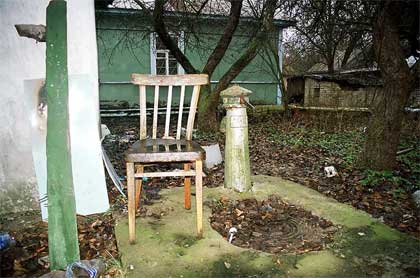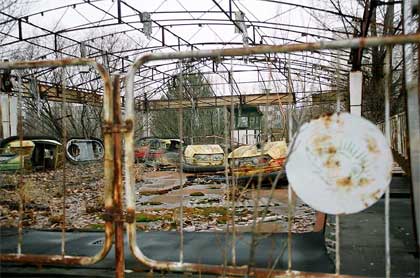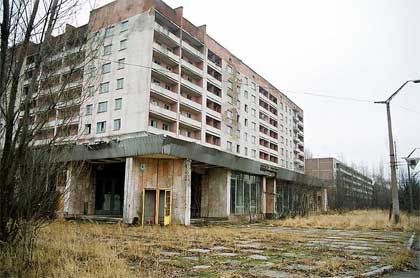Alice Miceli is currently traveling back and forth from Berlin where she is based now to Belarus where her aim is to capture radiation images in Chernobyl’s exclusion zone.

The pictures will be imprinted by the radiation that has contaminated this area, ever since the day of the disaster in April 1986. Although radiation is extensively present in the environment, it is totally invisible. The images she will produce will thus make visible this invisible energy that has turned the area into a “dead zone”.

The Chernobyl project, requires the creation of a technology that will enable the artist to take pictures with invisible gamma radiation inside the Chernobyl Exclusion zone, in Belarus.
I asked Alice to give us more details about the project:
Your first visit to Belarus doesn’t seen to have you back off from the project. Aren’t you afraid that, when you see the extent of radiation in your pictures, you will be thinking “Oh! Man! What am I doing here?”
On the contrary, when I first went to Belarus, I was already working on the technology to develop the camera for almost a year, but I had never actually been to the Chernobyl exclusion zone. Being there, made me witness the humanitarian crisis that this situation has been causing in Belarus, over the years.
Right after having returned to Rio, where I was then based, following nearly one year of research, I asked myself: how has this first trip altered the project? After crossing a big STOP sign and warnings in Russian about radiation, what has actually changed?
It seems to me that the central issue is the visibility / invisibility of radiation, which is the core concept of the “Chernobyl Project�?. Physical visibility, considering that my camera “sees�? the invisible – it sees an invisible matter. But also social-political visibility, considering that even though the reactor is across the border, in Ukraine, contamination is at higher levels in Belarus, a country that is even less socially visible than its neighbor. Globally, the public opinion and the European countries fail to recognize, let alone address, this problem. Something that was not only a traumatic event in the past – it is a current, urgent situation, and it will continue to be for hundred of years.
 What is it exactly that motivates your project and has put your health after your artistic project?
What is it exactly that motivates your project and has put your health after your artistic project?
How to look at a very intriguing place, the exclusion zone, in a specific way, specific to that place? I thought about what had happened there. This evil energy, where was it, where were its traces? Is it possible to sense it, to touch the immaterial, the invisible? It crossed my mind that this vast “waste ground�? had become a place where this invisible matter could not be contained any longer. The “Chernobyl Project�? attempts to make this visible.
The issue of health: as in radical sports, in dealing with dangerous situations, there are risks that you have to take, but you do so in the most careful, prudent way, to an extent where the risks are almost inexistent. Of course they do exist, you can never be sure to be 100 per cent safe, but then, when are we actually TOTALLY safe anyway? But for something to happen to me there, I would have to be living in the contaminated areas for decades, as sadly many people do out of not having a choice.
 Can you explain us how the specially created pinhole camera works technically? How challenging was it to develop it?
Can you explain us how the specially created pinhole camera works technically? How challenging was it to develop it?
Since I am not a physicist, I had to study radioactivity for this project. It was developed in collaboration with scientists at the Radio-Protection Institute, in Rio de Janeiro. Now it will be further developed at the Otto-Hug Radiation Institute, in Munich, before being tested in the zone. It is, so far, the most empiric, challenging thing I have ever done, as this process is a leap into the unknown, to something that comes to being, to a form, as we look at it.
The basic optic phenomenon of image projection on the back of a dark chamber, created by a tiny little hole, is the same of a regular pinhole camera that works with light. For a “radiographic version�?, it was necessary to make adjustments in this basic principle: we built a steel box with a led cover. Led is one of the few materials that stop radiation. The box is a shield to attenuate radiation and protect the film. The actual pinhole (that goes inside the box), is a led square cube that measures 5cm x 5cm, with a conic miniscule hole. It prints “projected�? images of contaminated matter on radiographic film, adjusted to the specific energy of the radioactive matter. The radiographic film is individually wrapped. It is placed in the camera inside a sealed aluminum envelope, which stops the penetration of light, but not of radiation, so it is only exposed to radioactivity.
Thanks Alice!
Images by Charles Hawley in Chernobyl.
See also: Bengt Sjölén and Adam Somlai-Fischer and Usman Haque’s device that takes photos of wifi space.
Related stories: A day trip to Chernobyl, Nuclear Nightmares, Design solutions for post crash civilization.
